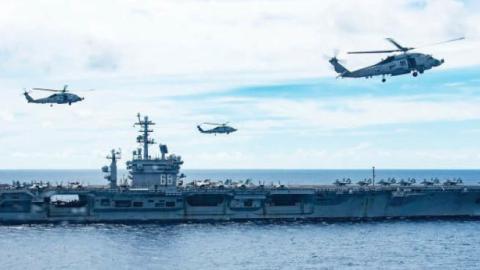Strategic uncertainty is a wild card in a nation’s plans because it is dominant in world affairs. A weak nation can become powerful in a few decades. An apparently strong one can collapse in a few years. Think of the global strategic environment as a lake of black swans. The U.S. is swimming in this lake today and antecedents within memory—relatively recent history— illustrate the supreme importance of grasping the unchangeable.
This week marks the 80th anniversary of the Battle of Britain, the largest extended air engagement in human history. Fought over nearly four months between July and October 1940, the battle pitted the Nazi Luftwaffe, hoping to gain air superiority and thereby enable a naval invasion, against the Royal Air Force defending British airspace. Cinema and fiction have immortalized the conflict’s tactical actions. As one would expect, few aspects of modern conflict capture the imagination like air combat, with hostile aviators and their flying machines engaged in a deadly ethereal dance.
But the flying machines that denied Hitler the air dominance needed for an invasion, and by extension ensured Europe’s future liberation from Nazi tyranny, were not the Royal Air Force’s preferred military tools. Indeed, throughout the interwar period British and American air planners were fixated on long-range bombers, believing that “aerial bombardment” against military-industrial sites and — in some cases — the civilian population would sweep away the need for all other armed forces. British fighter production did not begin in earnest until 1938. RAF Fighter Command, which coordinated British air defense throughout the Battle of Britain, was created in 1936. But Number 60 Group, the RAF formation responsible for air-defense radar coordination, was not established until February 1940, months into the so-called “Phony War.”
This demonstrates the fundamental uncertainty any military planner must confront when designing forces. Tactical and operational realities are extremely ambiguous until battle is joined. Moreover, technological advances can consign to obsolescence significant military investments — as they did to practically the entire bomber force of the RAF in 1938, or to imperial Germany’s cruiser squadrons in 1906. Even the most competent planners armed with the best intelligence must account for strategic uncertainty. The strategist must balance the demands of the moment with a fundamental criticality, a recognition of his own flawed information about his enemy and an understanding of Clausewitzean friction and the fog of war. Hence the necessity of strategic flexibility. The concept is typically applied to small-state nuclear weapons: British and French nuclear capabilities, for example, provide both states with strategic insurance in an increasingly uncertain geopolitical situation.
But a recognition of strategic uncertainty also has implications for conventional forces, particularly at sea. Naval power is the ultimate strategic enabler. Only ground forces can hold territory and physically impose one’s will upon the enemy. Modern ground combat is inseparable from air combat — whatever other roles an air force plays, coordination with ground forces through close air support or battlefield air interdiction will always remain a core mission. However, seapower provides a flexibility and depth unlike land power and airpower, and today “space power” and “cyberpower.” Particularly for a great power like the United States, seapower’s effects go far beyond direct warfighting. Of course, warships are built to destroy other warships. But the “sea control” that they obtain through fleet actions or amphibious assaults in turn facilitates all other military operations. More broadly, naval power allows its user to pressure the enemy’s economy through blockade in peacetime or wartime, transit forces between theaters unimpeded, communicate with—and by its presence, demonstrate support for—far-flung allies, and in modern contexts mount strikes against exposed targets inland. The U.S. understood this essential fact from its founding through most of the 20th century, although as America’s defense budget flattens while China’s continues its precipitous rise, the clarity of the U.S.’s understanding about the purpose of naval forces is diminishing.
The maritime domain is unique, with its own geography and logic as compared with land power. Indeed, land and sea are the two fundamental human geographic domains: The Greeks distinguished between maritime and terrestrial powers for this very reason. Understanding sea power — and, one must note, land power and arguably air power — therefore requires significant military and strategic specialization, stemming from the domain’s unique defining factors.
These unique factors make maritime power the most naturally political of military domains. Thus, it undergirds conventional deterrence in any great-power struggle. Major-power naval forces must operate forward. The natural constraints of maritime geography make the sort of “surge” capacity that airborne ground and air forces rely upon during conflict impossible because maritime transport takes time. The large-surface combatants, capital ships, and submarines that define blue-water naval power are by physical necessity relatively slow. Moreover, naval forces are naturally more expensive than their ground and air counterparts. They are flexible, versatile platforms designed to fulfill multiple missions, and built with the capacity for upgrades.
The oldest of the U.S.’s Nimitz-class aircraft carriers have served for 45 years, while the oldest of the U.S.’s Ohio-class ballistic-missile submarines have served for 39 years. This is a testament to both platforms’ flexibility. The big-deck supercarrier is a floating airfield, able to adapt to a variety of strategic circumstances. Similarly, the guided-missile submarine can be modified for conventional or nuclear missions. The only military asset outside of the Navy with the same sort of longevity is the B-52 Stratofortress strategic bomber, produced between 1952 and 1962 and still in service today. Major capital assets accrue strategic value over time because of their versatility. Hence the force-structure choices naval planners make today will have a far greater impact than those of their Army, Air Force, and Space Force counterparts.
The maritime domain’s supreme importance in the emerging great-power competition with China makes the U.S. military’s joint culture increasingly problematic. Today’s joint system circumscribes the individual authority of the services and makes the Chairman of the Joint Chiefs of Staff primus inter pares. One result is a roughly equal distribution of forces, missions, and budgets among the military services, an ironic outcome since this is one of the issues that Congress sought to remedy in its reorganization of the military. Congress set the current system in place over a third of a century ago to centralize the Defense Department. The pendulum has swung too far. Today, the sea services are constricted in articulating their own strategic concepts. The largest and most bureaucratically powerful service — the Army — can concentrate on accumulating bureaucratic power. Unlike the Navy, the Army is not required to operate around the world in peace much as it would in war. Relieved of this obligation, the Army gains a decisive advantage in staff positions and the power that accompanies them.
The current administration has demonstrated a distinct bias towards the Army. The current secretaries of State and Defense are both West Point graduates. Two of the president’s national-security advisors have been Army general officers. The current national-security advisor, Robert O’Brien, served as a Judge Advocate General in the Army Reserve. The Navy Department’s assistant secretary for research, development, and acquisition, James F. Geurts, was a career Air Force officer. A former acting secretary of the Navy, James McPherson, did serve as a rear admiral in the Navy’s Judge Advocate General’s Corps. But he concurrently served as the under secretary of the Army. The Navy’s interim civilian leader was therefore the fourth-most important Army decision-maker.
This land-service saturation has already removed internal strategy and force-planning assessments from the Navy’s control. Acting Secretary McPherson canceled outgoing acting Navy Secretary Thomas Modly’s Future Carrier 2030 study. The carrier may not last as long as the pyramids, but it is, at least for now, the core of naval combat power. An internally directed study on carrier development over the next decade would have allowed the Navy to assess its strategic requirements and articulate a service vision that matches long-term American policy goals.
Rather than using its own expertise to generate force-structure assessments, the Navy will instead rely on an Office of the Secretary of Defense (OSD) study that will “include a carrier review.” Of course, McPherson, and now Secretary Braithwaite, continued former acting Secretary of the Navy Tom Modly’s $40 billion cost-savings initiative. Similarly, the Cost Assessment and Program Evaluation office — OSD’s internal think tank — conducted a force-structure assessment that included significant fleet modifications, including the recommended reduction of the carrier force to only nine ships. For comparison, the Navy has not operated fewer than eleven fleet carriers since 1942, when combat losses reduced the carrier force to four ships.
Although the OSD study used Navy estimates as a baseline, the fact that such a robust force-structure assessment occurred largely absent Navy input is a sign that the competition of military ideas, as essential to protecting the nation as competition is to enterprise, is in trouble. Particularly in the aftermath of COVID-19, policymakers will encourage the armed services to cut costs without reconfiguring American interests. In a “joint” military, the branches with the least institutional power — the sea services — are unlikely to receive the share of the budget that their strategic importance merits. This will be a mistake. America’s deterrence and warfighting strategies in the single most important global strategic fulcrum, the West Pacific, center on naval power.
Read in National Review


















